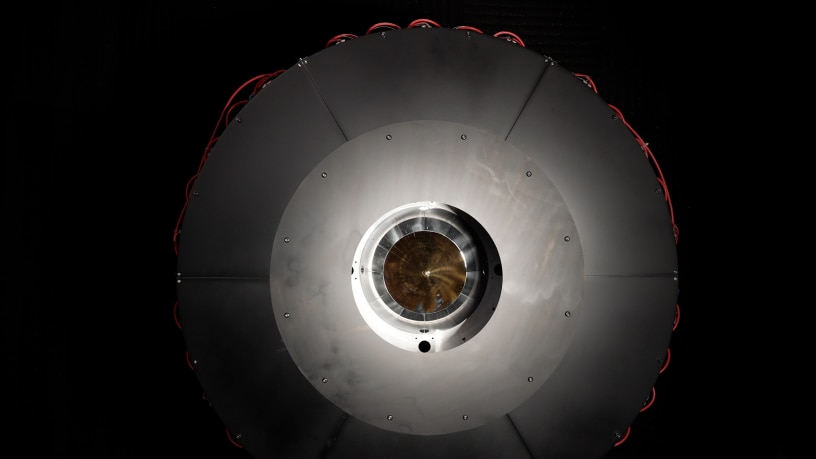
The laser enters the PRAD receiver through the center, reflects off a parabolic mirror, and hits photovoltaic cells that convert it into power. (Image Credit: DARPA)
A team in the U.S. Army's White Sands Missile Range used lasers to wirelessly transmit power, a method called optical power beaming. They achieved this feat from a distance of 5.3 miles, delivering 800 watts over a 30-second burst with an efficiency close to 20% at shorter distances. This technique could power off-grid sensors and remote research stations that use batteries or generators.
Optical power beaming involves transforming energy into a precisely controlled laser before transmitting it to a Power Receiver Array Demo (PRAD) receiver on the opposite end. This receiver has a parabolic mirror, a disk-shaped, curved reflective surface that focuses light onto photovoltaic cells that convert the light into electricity.
Most of the light is contained inside a compact aperture, ensuring minimal leakage when the receiver captures it. Without that system design, escaped light becomes wasted energy and a potential hazard. The PRAD passes the beam to dozens of solar cells surrounding the inner surface to share the load.
It took three months to design and build the receiver, a modular device that's scalable to higher powers. Scalability is important for future systems to supply power to vehicles or mobile bases.
What makes this feat unique is that the transmission didn't require clear skies. The team beamed the laser into thick, dusty parts of the atmosphere near the ground, a very difficult path for clean optical beam transmission. During tests, the team delivered over a megajoule of power, which adds up with each short shot.
According to a DARPA program manager, this accomplishment beat initial optical power beaming demonstrations in terms of power or distance. It also defied beliefs about how far optical laser beams can travel. Earlier demonstrations weren't as impressive as this one, as they'd distribute power over shorter distances.
This system could be used to power uncrewed aircraft. For instance, a drone equipped with the receiver could receive power in mid-flight, extending its air time without landing for a battery change. In the future, the program intends to add sky-based relays to form a chain of extended energy links. Doing so enables vertical shots in the thin, clean parts of the atmosphere, leading to better hops.
In the future, the team will demonstrate that the relays can capture a beam with minimal power loss before passing it along. This helps determine if long chains can be used at a practical level. Additionally, power moving targets could be the next goal. Ensuring the light stays on the receiver of a UAV poses challenges, so it must have excellent tracking and stability.
It's also not a replacement for grids, as it's meant to be used in places where wires can't reach safely. In this case, an optical link could power clinics, communications hubs, or water pumps as workers restore lines in emergencies.
Have a story tip? Message me here at element14.
